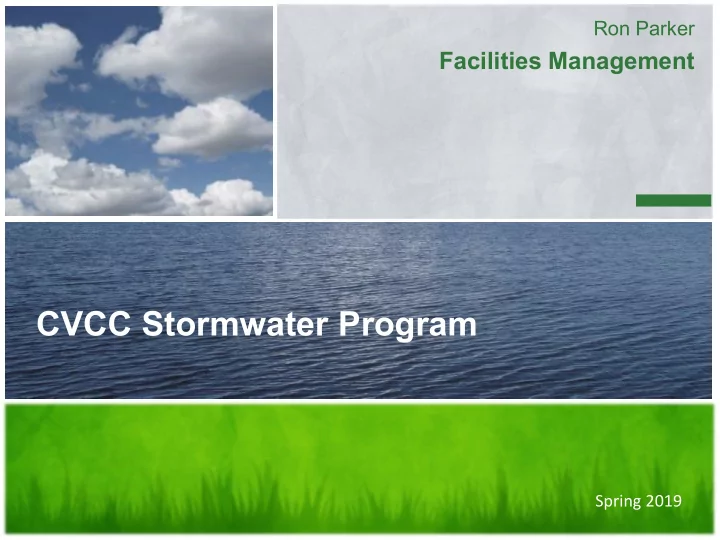

Ron Parker Facilities Management CVCC Stormwater Program Spring 2019
IMPACTS OF STORMWATER RUNOFF • Sediment from construction sites, bare and Carries other pollutants to water bodies which adversely affects wildlife. denuded areas without vegetative cover, and • Clogs fish gills which interferes with streambank erosion due to high volumes of breathing and kills fish. rainwater runoff caused by urbanization. • Creates a muddy bottom which adversely affects spawning beds. • Reduces visibility due to suspended particles affecting the ability of fish to locate prey. • Decreases the depth of the water which increases water temperatures which forces fish and animals to find a more suitable environment to live. • Reduces light penetration which adversely affects plant growth. • Interferes with navigation, flood control, recreation and fishing industries.
EFFECTS OF POLLUTION ON ENVIRONMENT Nitrogen and Phosphorous in fertilizers cause algae blooms in water bodies. Excessive algae produce toxins that sicken or kill people and wildlife. Improperly disposed of animal waste and human waste from sanitary overflows cause high levels of bacteria (E.coli) in water bodies. Excessive E.coli makes water bodies unsafe for swimming and can sicken or kill people and wildlife.
APPLICABLE STORMWATER REGULATIONS WHY WE HAVE TO? Clean Water Act (CWA) protects Virginia’s waters WHO SAYS? Compliance & Enforcement WHERE APPLICABLE? MS4 General Permit Entity • Localities & State Entities within urbanized areas • Special Conditions for TMDLs
MUNICIPAL SEPARATE STORM SEWER SYSTEM (MS4) • Collects & conveys stormwater – Potential to convey pollutants downstream – Ultimately leads to a point discharge at a natural drainage way (outfall) • Activities/operations draining to outfalls are regulated if within a Census Urbanized Area (MS-4 Area)
TOTAL MAXIMUM DAILY LOAD (TMDL) Waterbody not meeting water quality standards • TMDL is a plan (pollution diet) that establishes the maximum amount of a pollutant the waterbody can hold and Assign WLA for meet water quality standards. pollutant(s) of • WLA is the quantity of the pollutant concern (POC) to (sediment, nitrogen, bacteria, etc.) that point sources may be discharged.
CHESAPEAKE BAY TMDLS ▪ The Chesapeake Bay is impaired for Nitrogen, Phosphorous and Sediment. ▪ CVCC implements a Chesapeake Bay TMDL Action Plan to reduce the Pollutants of Concern (POCs) based on the amount of impervious area (hard surfaces like roads, sidewalks and building footprints) on campus. ▪ Currently, CVCC uses street sweeping as a Best Management Practice to achieve the required reductions. ▪ CVCC also abides by the construction laws and regulations that reduces the amount of sediment from construction activities. ▪ CVCC also implements a Nutrient Management Plan to reduce the amount of Nitrogen and Phosphorous applied in the form of fertilizer on the campus.
SEDIMENT AS A POLLUTANT (TMDL)
LOCAL IMPAIRED WATERWAYS ▪ CVCC directly discharges into an unnamed tributary of Burton Creek which is not impaired; however, downstream of the College is the James River which is designated as an impaired waterway. ▪ DEQ’s 2016 impaired waters list identifies James River as impaired for: • E. coli (bacteria). ▪ Pollutant sources of E. coli: livestock and pet waste and sanitary sewer overflows. ▪ Steps taken to reduce pollution of impaired waterways: • Pick-up pet waste; and • Inspect sanitary sewer system for signs of overflows.
BACTERIA (E. COLI) TMDL • Animal waste and human waste – Sewer overflows – Leaking sewer lines – Failing/unmaintained septic systems – Urban stormwater runoff – Livestock operations – Pet waste – Wildlife • Excessive E.coli makes water bodies unsafe for human contact – may exhibit fever, diarrhea and abdominal cramps, chest pain, or hepatitis
DEFINING AN ILLICIT DISCHARGE • Illicit Discharge ‐ Any discharge to an MS4 that is not composed entirely of stormwater, except discharges specifically identified in the Virginia Administrative Code and determined by CVCC not to be a significant contributor of pollutants to the MS4.
DEFINING AN ILLICIT DISCHARGE (IMAGES)
DEFINING AN ILLICIT DISCHARGE (EXAMPLES) An illicit discharge can: 1. Be a measurable flow from a storm drain during dry weather that contains pollutants or pathogens; 2. Have a unique frequency, composition, and mode of entry in the storm drain system; 3. Be caused when the sewage disposal system interacts with the storm drain system; and 4. Can be discharges from pollutants from specific source areas Table 1. Examples of source pollutants of an illicit discharge. • • Automotive fluids (oil, fuel, antifreeze) Landscape waste (grass clippings, etc.) • • Cooking oil and grease Improperly applied fertilizer • • Solvents Sediment • • Paints Vehicle wash water • • Chemical cleansers (detergents, soaps) Sanitary sewer wastewaters • • Improperly applied pesticides/herbicides Dumpster leachate • • Improperly managed salts Trash
DEFINING AN ILLICIT DISCHARGE (NOT ILLICIT) Table 2. Examples of sources that are not considered illicit discharges. • • Fire-fighting activities Air conditioning condensate • • Water line flushing Footing or foundation drains • • Landscape/lawn irrigation Springs • • Diverted stream flows Water from crawl space pumps • • Rising groundwater Dechlorinated swimming pool wastewater • • Uncontaminated groundwater infiltration Discharges from potable water sources • • Uncontaminated pumped groundwater Flows from riparian habitats and wetlands
DEFINING AN ILLICIT DISCHARGE (CARTOONS)
CVCC’S PROHIBITION OF ILLICIT DISCHARGE Source/Discharge Type Elimination Authority Intentional by Student Student handbook Intentional by Faculty/Staff Standards of Conduct for Employees Staff During Daily Operations Good Housekeeping/Pollution Prevention Manual Contractor Operation Contract Language
REPORTING AN ILLICIT DISCHARGE Report observed concerns to Facilities Management Office: • Call 434.832.7736 or • Email: facilities@centralvirginia.edu or • Check out our website by searching Facilities Management or https://www.centralvirginia.edu/Campus-Life/Locations- Facilities/Facilities-Management
QUESTIONS? CVCC Ronald R. Parker (Facilities Supervisor)
Recommend
More recommend